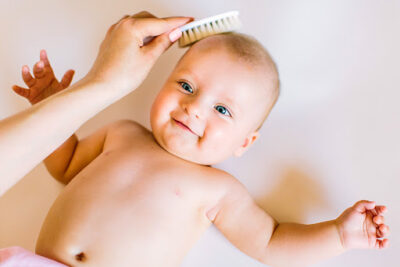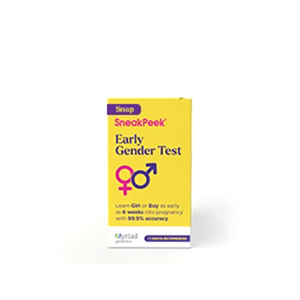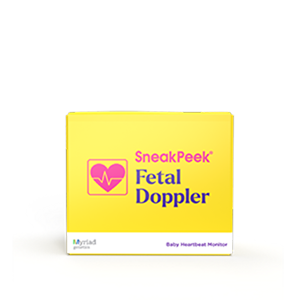Published on October 3rd, 2022 and Updated on January 15th, 2024
Check out SneakPeek Gender Test to find out your baby’s gender as early as 6 weeks at over 99% accuracy1!
The color and texture of our hair are two of the most recognizable physical traits we possess as adults. Therefore, it’s exciting to watch the metamorphosis of those first strands on your baby’s head during the first year.
While some babies are born with a full head of hair, others come out of the womb smooth and mane-free. Some babies even shed their initial curls, eventually re-growing a whole head of differently textured hair. So, the question remains: when will my baby’s hair grow—and stick?
The short answer is that most babies will grow, or re-grow, hair on their heads between 6 to 12 months of life. How thick that hair is, however, or what hue it initially takes depends on a few key factors.
This guide will teach you everything you need to know about your little one’s hair growth, plus three additional aesthetic milestones (like whether she’ll inherit your baby blues!), to watch for.
What physical changes will my baby go through first?
Your little one will develop so rapidly in the first year that you might wonder if she’s changing before your very eyes.
Some of the most noticeable changes you’ll see include:
- Size
- Skin color
- Eye color
- Hair
Below, we’ll dive right into baby hair growth 101 before tackling some of the other attributes listed.
Why are some babies born with hair?
Scientists believe that genetics and chromosomes determine how much hair your baby greets the world with. Regardless of how much hair he sports to start, the hair your baby is born with will slowly fall out in the first 2 to 6 months of life.
Additionally, some babies are born with different kinds of hair. A downy, sometimes-dark layer on the back, shoulders, ears, and face is called lanugo, and it develops in the womb to help keep your baby warm.
Most babies shed their lanugo in the womb between 32 to 36 weeks, but around a third of babies are born with it still intact. If your little one is born with this hair all over his body, there’s no need to worry. Any signs of lanugo will drop away within the first 2 months of life.
Baby’s Hair Growth Journey Timeline
Your baby’s hair growth journey begins before birth (in the prenatal phase of life) and continues through the postnatal stages (after birth). Keep in mind that weeks denoted in the prenatal phase refer to how many weeks of pregnancy have passed, while weeks in the postnatal phase mark time since birth.
Here’s what’s going on in the prenatal stages of hair growth:
- 14 to 15 weeks (into pregnancy) – Around now, your baby’s hair follicles make their first appearance, followed closely by actual baby hair growth on the scalp. While you may catch a glimpse of this on an ultrasound, these hairs will be shed in utero and replaced by one or two additional layers before birth.
- 21 to 22 weeks – This is when your baby’s eyelashes and eyebrows start to come in, and also when lanugo first develops.
After delivery day, you’ll begin to see changes in your baby’s healthy hair for yourself. Here’s what to expect:
- 8 to 24 weeks (after birth) – Any hair your baby is born with will start shedding during this period. The scientific term for this is telogen effluvium, and it’s part of the normal developmental timeline for our little ones. This process is largely due to hormonal changes. While in utero, your baby absorbs hormones that keep her mane intact—but when she loses access to them after birth, this change prompts hair follicles to shed.
- 6 to 12 months – After losing any initial hair between weeks 8 and 24, your baby may begin growing new hair in the second half of the first year. You may be surprised to notice that this hair, called terminal hair, is a different color or texture than what you saw in the first few months of her life. This healthy hair growth, too, is completely normal—it’s due to your baby’s hair follicles continuing to develop post-birth and the lack of those in utero hormones.
What determines the thickness of my baby’s hair?
How full a head of hair your child develops, in infancy and throughout life, is determined by genetics. In one study, scientists determined that the EDAR gene is a major contributor to head hair fiber thickness in East Asians, whose hair strands are about 30% thicker than the average population.
After lanugo—a.k.a., baby body hair—is shed (either before birth or within the first 2 months of life), babies grow a type of peach fuzz known as vellus hair on their scalps, faces, and all over their bodies. Vellus hair is thin, usually light in color, and shows up between 3 to 7 months after birth.
Vellus hair on the scalp is replaced by thicker, coarser terminal hair by two years of age, but elsewhere on the body, vellus hair is typically permanent.
What factors influence my baby’s hair color?
Since those earliest months of pregnancy, you may have been wondering what color hair your baby will have. Unsurprisingly, the exact color your baby ends up with is determined by your and your partner’s genetics.
Your baby gets his unique hair color thanks to a pigment called melanin. Melanin comes in two variations, eumelanin and pheomelanin, and how they mix together determines the exact hue on your little guy’s head.
How To Care For & Promote Baby Hair Growth
While monitoring all these early changes to your baby’s hair, you may wonder how to care for your baby’s hair and ways to help your baby’s hair grow. Luckily we got you covered:
- Maintain a Healthy Diet- A well-balanced diet with vitamins A, C, and E, as well as biotin, zinc, and iron, supports hair growth.
- Gentle Scalp Massage- Stimulate blood flow to every hair follicle by massaging your baby’s scalp in circular motions.
- Regularly Cleanse the Scalp- Use gentle baby shampoo 2-3 times a week to maintain a clean scalp.
- Use a Soft Brush or Comb: Gently detangle your baby’s hair with a soft-bristled brush or wide-toothed comb.
- Be Mindful of Products- Choose baby-friendly, chemical-free hair care products.
- Protect from the Sun- Shield your baby’s scalp from the sun’s rays with a hat or lightweight scarf.
Eyes, Skin, and Size: 3 Other Milestones To Look Out For
In the first two years of life, your baby will undergo a host of physical changes as she transforms from precious baby to curious toddler.
Let’s take a look at three distinguishing features: eye color, skin shade, and size.
#1 Changing Eye Color
Like hair color, eye color is determined by the amount of melanin in the iris, or the colored part of the eye. The more melanin in the iris, the darker the shade and color.
This usually means:
- A small amount of melanin can result in blue eyes
- A moderate amount may result in green eyes
- A large amount of melanin can lead to brown eyes
When we talk about changes in eye color, we’re typically talking about how the irises darken due to an increase in melanin production. This typically occurs in the first 6 to 8 months of life, which explains why a little over 60% of babies are born with brown eyes, while nearly 80% of humans have brown eyes as adults.
#2 Changing Skin Color
Research indicates that a baby’s skin color can change shades early on, often lightening and becoming less red between the first 2 to 20 months. This is caused by a variety of factors, including:
- Skin thickening
- Healed or resolved newborn jaundice (which can yellow the skin)
- Circulatory system maturation
While researchers are still explaining why this happens, most parents can expect their baby’s skin to mature over time. Often, this results in subtle color changes between birth and age two.
#3 Size
At times, your little one grows so rapidly that it feels like she doesn’t fit into clothes you bought just last weekend! While the size of every newborn varies, most little ones reach growth milestones in their first year:
- 5 months – Your baby will double her birth weight
- Between 6 to 12 months – Your baby will grow about one centimeter per month
- 12 months – Your baby will triple her birth weight
As growing babies pass each marker with flying colors (be they eye- or skin-related) in the early months, few things are more rewarding than witnessing the transformation from a little bundle in a bassinet to a sturdy young toddler.
In conclusion, understanding your baby’s hair growth and other significant milestones is an exciting part of their early development, each presenting unique changes that are a testament to the wonder of biology. Always remember that every baby grows at their own pace, so these timelines may vary—just enjoy this special time of growth and discovery with your little one.
Sources:
- Romper. Why Some Babies Have Fabio-Like Locks At Birth. https://www.romper.com/p/why-do-some-babies-have-lots-of-hair-when-theyre-born-28191
- Babycentre. Baby hair loss. https://www.babycentre.co.uk/a85/baby-hair-loss
- Babycenter. Fetal development: Your baby’s hair. https://www.babycenter.com/pregnancy/your-baby/fetal-development-your-babys-hair_40005852
- Today’s Parent. What you need to know about babies born with hair or lanugo. https://www.todaysparent.com/baby/baby-development/lanugo-babies-born-with-hair/
- Cleveland Clinic. Lanugo. https://my.clevelandclinic.org/health/body/22487-lanugo#
- What To Expect. When Babies Start Growing Hair, Skin and Nails. https://www.whattoexpect.com/pregnancy/fetal-development/fetal-hair-skin-nails/#
- The Baby Spot. When Do Baby Eyebrows Come In? https://thebabyspot.ca/when-do-baby-eyebrows-come-in/#
- Healthline. Newborn Hair: Everywhere or Barely There, It’s All Normal. https://www.healthline.com/health/baby/newborn-hair#in-utero
- Ovia Health. When do babies grow hair? https://www.oviahealth.com/guide/10832/when-do-babies-grow-hair/
- Human Genetics. A replication study confirmed the EDAR gene to be a major contributor to population differentiation regarding head hair thickness in Asia. https://pubmed.ncbi.nlm.nih.gov/18704500/
- Science. A Thick Head of Hair Is in the Genes. https://www.science.org/content/article/thick-head-hair-genes
- Cleveland Clinic. Vellus Hair (Peach Fuzz). https://my.clevelandclinic.org/health/body/23098-vellus-hair-peach-fuzz
- Medscape. Scalp Hair Characteristics in the Newborn Infant. https://www.medscape.com/viewarticle/466530_4#
- Mom News Daily. When do Babies Hair Texture Change? https://www.momnewsdaily.com/baby/developments/when-do-babies-hair-texture-change/#what-is-baby-hair-texture
- MedlinePlus. Is hair color determined by genetics? https://medlineplus.gov/genetics/understanding/traits/haircolor/
- Acta Ophthalmologica. What Color Are Newborns’ Eyes? Prevalence of Iris Color in the Newborn Eye Screening Test (NEST) Study. https://www.ncbi.nlm.nih.gov/pmc/articles/PMC4956505/#
- Insider. When newborns’ eyes change color and the most common eye color. https://www.insider.com/guides/parenting/when-do-newborns-eyes-change-color
- Skin Research and Technology. Infant Skin Maturation: Preliminary Outcomes for Color and Biomechanical Properties. https://www.ncbi.nlm.nih.gov/pmc/articles/PMC5600644/
- MedicalNewsToday. Babies and skin color: A guide. https://www.medicalnewstoday.com/articles/are-black-babies-born-white
- The Mayo Clinic. Infant and Toddler Health. https://www.mayoclinic.org/healthy-lifestyle/infant-and-toddler-health/basics/infant-and-toddler-health/hlv-20049400

Shop Our Products
SneakPeek aims to provide the most accurate and up-to-date information to help our readers make informed decisions regarding their health before, during, and after pregnancy. This article was written based upon trusted scientific research studies and/or articles. Credible information sources for this article are cited and hyperlinked.





